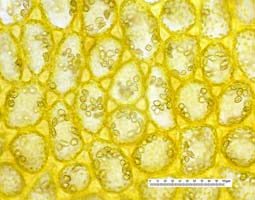Guide to Liverworts of Oregon: Mylia anomala (Hook.) S.F. Gray
HOME SPECIES INDEX GENUS INDEX GLOSSARY
HOME > 1 plants leafy > 3 leaves not divided, not ciliate > 6 oil bodies 2+ or unknown > 7no small dorsal lobe > 10 succubous > 11 anisophyllous > 12 leaves unlobed > 28 underleaves conspicuous > 32b underleaves entire > 36b leaf cells large > Mylia anomala
Synonym: Leiomylia anomala (Hook.) J.J. Engel et Braggins. (Taxon 54(2005):665-680.)
Special Status: None.
Recognition: The habitat, growing on Sphagnum, is a critical character. The gemmae at shoot tips; consistent presence of underleaves; and large, bulging trigones distinguish this species. Other wise it mimics Jungermannia leiantha (which sometimes has gemmae but almost never underleaves) and Jamesoniella autumnalis (which lacks gemmae and only occassionally has prominent underleaves); neither of these look-alikes has trigones that bulge as much.
Distribution: On Sphagnum; in both coastal and montane bogs.
Comments: The name proposed by Engel and Braggins appears to be the one we should be using and I will probably adopt it after checking out the reference and being sure I get the combination correct.
Mylia taylori has been found in Washington State and northwards. It is characterized by a thick, prominently cracked cuticle.

 Left: sterile shoot. Right: sterile shoot showing underleaf. White Rock Fen, Linn Co., Oregon. DHW
m1682.
Left: sterile shoot. Right: sterile shoot showing underleaf. White Rock Fen, Linn Co., Oregon. DHW
m1682.

 Left: gemmiferous shoot. Right: detached leaf. White Rock Fen, Linn Co., Oregon. DHW
m1682.
Left: gemmiferous shoot. Right: detached leaf. White Rock Fen, Linn Co., Oregon. DHW
m1682.

 Left: underleaves. Right: cells with oilbodies. White Rock Fen, Linn Co., Oregon. DHW
m1682.
Left: underleaves. Right: cells with oilbodies. White Rock Fen, Linn Co., Oregon. DHW
m1682.